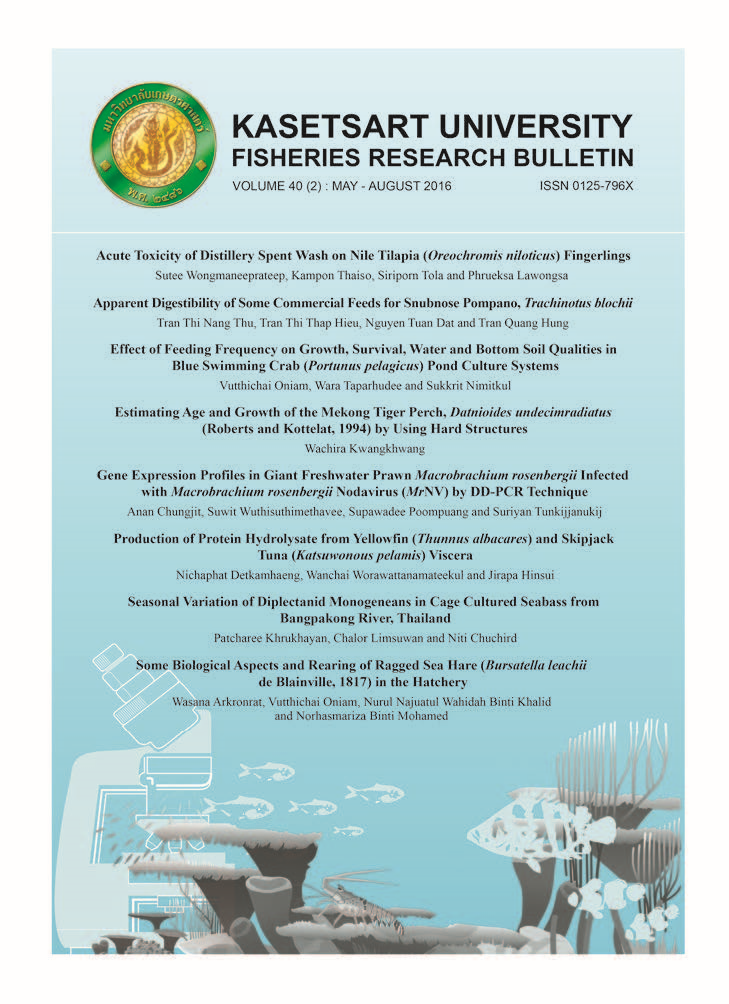Some Biological Aspects and Rearing of Ragged Sea Hare (Bursatella leachii de Blainville, 1817) in the Hatchery
Main Article Content
Abstract
Samples of the ragged sea hare, Bursatella leachii, were collected in the marine shrimp ponds during December 2014-January 2015 to study some biological aspects (spawning and egg development) and condition factors (feedstock, substrates and stocking density) on reared B. leachii. The results showed that under hatchery conditions (salinity 32 ppt, water temperature 28.5-29.1°C, DO 4.19-5.11 mg/L and pH 8.14-8.32), B. leachii adults were clustered together in groups of 3-5 individuals for spawning. Egg development from brownish to dark brown took 6-7 days until newly hatched veligers (larval stage 1) were produced. The results of the condition factors experiment showed that the mean body weight of B. leachii fed with seaweeds (Caulerpa sp.) and mixed feeds (50% seaweeds, fresh weight and 50% shrimp feed No. 2, pellet size about 0.8-1 mm) increased, whereas it decreased when B. leachii was fed with shrimp feed No. 2. Rearing without or with sand substrate increased the growth of ragged sea hare, but having a clay substrate adversely affected growth. The growth and survival rates of B. leachii reared at stocking densities of 5, 10 and 15 sea hares/100 L (or about 2.5, 5.0 and 7.5 kg sea hares/m3, respectively) were not significant different. This study recommends that B. leachii can be reared and spawned in a hatchery, with feedstock and substrates affecting growth, whereas stocking density not affecting growth and survival.
Article Details
References
2. Avila, C. 2006. Molluscan natural products as biological models: chemical ecology, histology and laboratory culture. Progress In Molecular and Subcellular Biology 43:1-23.
3. Capper, A. I.R. Tibbetts, J.M. O'Neil and G.R. Shaw. 2006. Dietary selectivity for the toxic cyanobacterium Lyngbya majuscula and resultant growth rates in two species of opisthobranch mollusk. Journal of Experimental Marine Biology and Ecology 331 (2): 133-144.
4. Clarke, C. 2006. The population dynamics and feeding preferences of Bursatella leachii (Opisthobranchia: Anaspidea) in northeast Queensland, Australia. Records of the Western Australian Museum Supplement 69: 11-21.
5. Gofas, S. and A. Zenetos. 2003. Exotic molluscs in the Mediterranean basin: current status and perspectives. Oceanography and Marine Biology: An Annual Review 41: 237-277.
6. Haefner, B. 2003. Drugs from the deep: marine natural products as drugs candidates. Drug Discovery Today 8: 536-544.
7. Kazak, M. and L. Cavas. 2007. On the occurrence of Bursatell leachii de Blainville, 1817 in Izmir Bay, Turkey. Mediterranean Marine Science 8 (2): 87-90.
8. Otero, M.E. Cebrian, P. Francour, P.B. Galil and D. Savini. 2013. Monitoring Marine Invasive Species in Mediterranean Marine Protected Areas (MPAs): A strategy and practical guide for managers. IUCN, Malaga, Spain. 133 pp.
9. Özvarol, Y. 2014. The distribution of the lessepsian ragged sea hare, Bursatella leachii Blainville, 1817 (Aplysiidae) in the Mediterranean coast of Turkey. Journal of Fisheries Science 8 (4): 298-302.
10. Rajaganapathi, J.K. Kathiresan and T.P. Singh. 2002. Purification of anti-HIV protein from purple fluid of the sea hare Bursatella leachii de Blainville. Marine Biotechnology 4: 447-453.
11. Ramos, L.J., J.L.L. Rocafort and M.W. Miller. 1995. Behavior Patterns of the Aplysiid Gastropod Bursatella leachii in Its Natural Habitat and in the Laboratory. Neurobiology of Learning and Memory 63 (3): 246-259.
12. Sethi, S., M.R. Kokane, S.K. Ottaand G. Sethi. 2015. First record of ragged sea hare Bursatella leachii Blainville, 1817 (Opisthobranchia: Euopisthobranchia: Aplysiidae) in Pulicat Lake, east coast of India. Marine Biodiversity Records 8: 1-3.
13. Vue, Z. 2009. Evolution of shell loss in Opisthobranch Gastropods: Sea hares (Opisthobranchia, Anaspidea) as a model system. Master thesis, University of California, Merced.
14. Vue, Z., B.S. Kamel, T.R. Capo, A.T. Bardales and M. Medina. 2014. Comparative analysis of early ontogeny in Bursatella leachii and Aplysia californica. PeerJ2:e700: 1-33.
15. Wagele, H. and A. Klussmann-Kolb, 2005. Opisthobranchia (Mollusca, Gastropoda) -more than just slimy slugs. Shell reduction and its implications on defence and foraging. Frontiers in Zoology 2: 1-18.
16. Zakhama-Sraieb, R, S. Ramzi and F. Charfi Cheirkhroucha. 2009. On the occurrence of Bursatella leachii De Blainville, 1817 and Pinctada radiate (Leach, 1814) in the Gar El Melh lagoon (NE Tunisia). Aquatic Invasions 4 (2): 381-383.

